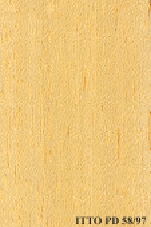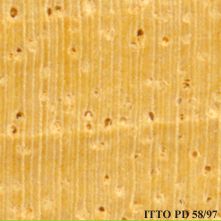
AYOUS/SAMBA/OBECHE (Triplochiton scleroxylon)
Trade Name
Ayous/Samba/Obeche
Scientific Name
Triplochiton scleroxylon K.Schum.
Family
STERCULIACEAE
Common Names
Samba (Côte d`Ivoire); Samba (Benin); Ayous (Equatorial Guinea); M'bado (Central African Republic); Ayus (Cameroon); Wawa arera; Soft satinwood; Owowa; Otrotso; Obeke; Obechi; Nkom; Larana whitewood; Ejoung; Bush maple; Bado; Ayos; African whitewood; Ayous (France); Wawa (United Kingdom); Obeche (United Kingdom); Samba (France); Ayus (Equatorial Guinea); M`bado (Central African Republic); Ayous (Cameroon); Obeche (Nigeria); Arere (Nigeria); Wawa (Ghana); Abachi (Netherlands); Abachi (Germany)
Scientific Name Synonyms
Samba scleroxylon (K. Schum.) Roberty
Description Of The Tree
Botanical Description
The tree reaches a height of 50 to more than 50 m. The bole is cylindrical, straight and clear to 26 m in length, buttressed to 6 m. The trunk diameter attains 170 cm.
Natural Habitat
Triplochiton scleroxylon occurs in abundance in transitional forest formations. National conservation status in Benin V.
Natural Distribution
West Africa, from Guinea to Cameroon.
Plantations Available?
This species has been planted with reasonable success in several countries of west and central Africa, including Nigeria and Ghana, and also in areas outside of its natural range in Cote d`Ivoire, Rep. of the Congo, and Dem. Rep. of the Congo.
Wood Identification
Anatomic Description Of Wood
Wood diffuse porous. Occasionally vessels exclusively solitary (over 90%). Tangential diameter of vessel lumina 200 micras or more (large). Non-vestured pits. Vessels per mm2 less than 6 (rare). Simple perforation plates. Vessel-ray pits similar to intervessel Apotracheal axial parenchyma diffuse and/or diffuse in aggregates. Paratracheal axial parenchyma scanty and/or vasicentric. Axial parenchyma storied. Prismatic crystals in non-chambered axial parenchyma cells. Two cells per parenchyma strand. 4 to 10 rays per mm (medium). Rays and/or axial elements irregularly storied. Rays non-storied. Larger rays more than 4 seriate. Prismatic crystals in the ray cells. Heterogeneous rays and/or multiseriate heterogeneous rays. Non-septate fibers. Fibers with simple to minutely bordered pits.
-
 Wood Macro Photo Tangential Plane
Wood Macro Photo Tangential Plane
-
 Wood Micro Photo Of Transversal Section
Wood Micro Photo Of Transversal Section
Availability
Cites Status
Unrestricted
General Wood Description
Color
The heartwood is whitish to pale straw, it is not clearly demarcated. The silver figure is fine (barely visible).
COLOR INDEX (1=Black, 7=Light yellow,white)
7
Grain
Straight or slightly interlocked, sometimes with an influence on further processing operations.
Texture
Texture is reported to be medium to coarse.
Luster
Luster is usually low.
Natural Durability
Not durable; important risks of decay attacks at any processing step, from logs up to final products. It must receive preservative treatment. Sensible to termites attack. The heartwood is sensible to Lyctus attacks.
Natural durability index (1= Very high durability, 7=Vey low durability)
5
Internal Growth Stresses
No growth stresses are reported in this species.
Silica Content
Silica Content: Silica content is negligible. Amounts over 0.05% may affect wood processing. Silica Value: 0.01
Resistance To Impregnation
Difficult to treat with only a low penetration of the preservative products.
Wood Physical Properties
Basic Density or Specific Gravity (O.D. weight/vol. green) (g/cm³)
0.36
Air-dry Density (Weight and volume at 12%MC) (g/cm³)
0.38
Total shrinkage Tangential (Saturated to 0%MC) (%)
5.0
Total shrinkage Radial (Saturated to 0%MC) (%)
2.9
Drying Defects
Ease of Drying: Drying is rather slow and sometimes difficult to perform. Drying Defects: Risks of distortions. Kiln Schedules: Schedule proposed as a reference by comparison with well known species taking into account to the general technological behavior of this species.
Recommended Dry Kiln Schedule
FR-2
Dimensional stability ratio (Total Tangential Shrinkage %/Total Radial Shrinkage %)
1.7
Wood Chemical Properties
Wood Mechanical Properties
Bending Strength (MOR),12%MC (kgf/cm²)
533
Stiffness (MOE) 12%MC (kgf/cm²)
74047
Compression parallel to fiber 12%MC (kgf/cm²)
306
Compression perpendicular to fiber 12%MC (kgf/cm²)
32
Shear strength radial 12%MC (kgf/cm²)
36
Janka hardness (side) 12%MC (kgf)
174
Janka hardness (end grain) 12%MC (kgf)
261
Workability
Sawing
It is easy to saw.
Rotary Veneer Cutting
Suitable for slicing and peeling.
Sliced Veneer
Suitable for slicing and peeling.
Blunting Effect
Slight blunting effect; ordinary tools can be used for sawing and machining.
Machining
Machining of this species is reportedly easy.
Planing
Easy; no particular problems.
Moulding
Easy; no particular problems.
Turning
30
Boring
Easy; no particular problems.
Mortising
Easy; no particular problems.
Nailing
Easy to perform but low nails holding.
Gluing
Glues well if basic gluing technical rules are followed.
Sanding
Particular care is needed to avoid woolly aspect of the surface.
Polishing
Needs pre-coating.
Steam Bending
This species can be used for steam bending.
Response To Hand Tools
No particular problems.
REFERENCED USES
End Uses Summary
HOUSING GENERAL, boards, frames, steps, panelling, fittings, FURNITURE AND CABINETS, luxury furniture, cabinets, PLYWOOD AND VENEER, faces, Decorative veneer, TURNING, ornaments, turned furniture, OTHER AND MUSICAL INSTRUMENTS, handicrafts, matches, door core, coffin, moldings, cementboard
General Housing
- 10 - Silica in Timbers
Boards
- 13 - Dry kiln schedules for commercial woods. Temperate and tropical. Section III. Latin American (Mexico, Central, and South America) Woods–Conventional Temperatures
Frames
- 16 - Woods of the World
Steps
- 17 - Tree Conservation Database
Paneling
- 18 - W3TROPICOS Missouri Botanical Garden
Fittings
- 19 - Silica in Timbers
Furniture Cabinets
- 21 - Tropical timbers of the world. Part III-Southeast Asian and Oceanian Species.
Furniture, Luxury
- 22 - Dry kiln schedules for commercial woods. Temperate and tropical. Section IV-Asian and Oceanian Woods
Cabinet
- 24 - Empire Timbers
Panels, Veneers
- 25 - Directory of Timber Trade Malaysia
Faces
- 26 - Annual Review and Assessment of the World Timber Situation 1998-ITTO
Decorative veneer
- 28 - Ministry of Agriculture, Fisheries & Forest of Fiji
Turning
- 30 - Embassy of Honduras in Japan
Ornaments
- 31 - Embassy of Colombia in Japan
Turned Articles
- 32 - Embassy of Cote d`Ivoire in Japan
Handcraft
- 66 - Maderas latinoamericanas. VII. Caracteristicas anatomicas. propiedades fisicomecanicas, de secado, y tratabilidad de la madera juvenil de Cordia alliodora (Ruiz & Pav. Oken.)
Matches
- 71 - Proprietes physiques et mecaniques des bois tropicaux, premier supplement
Door Cores
- 76 - Descripción General y Anatómica de 105 Maderas del Grupo Andino.
Coffin
- 78 - Amazonian Timbers for the International Market
Molding
- 79 - Padronização da Nomenclatura Comercial Brasileira das Madeiras Tropicais Amazônicas, Sugestão
Cementboard
- 81 - Madeiras da Amazônia: descrição do lenho de 40 espécies ocorrentes na Floresta Nacional do Tapajós
Please Provide Information To View Producer Information